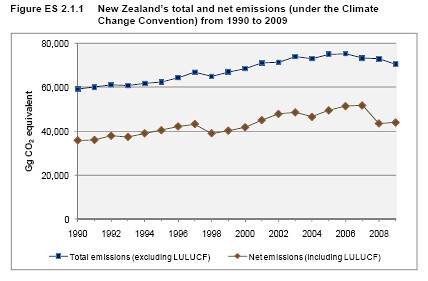The Ministry for the Environment released its latest inventory report [PDF] today. The headline data is shown in the graph below (stolen from p. vi) :

Gross emissions fell for the third year in a row, thanks to two things: good weather, meaning more water for hydro, and less need to burn fossil fuels for electricity; and the recession, which saw transport and agricultural emissions drop. Neither is anything to do with government policy, and Nick Smith, to his credit, acknowledges this. While the ETS has had a big impact on forestry (that 10 MT dip in net emissions in 2008 as deforestation came to an abrupt halt), it only came into force for energy and industrial emissions in mid 2010, so we won't know for two more years whether its had any effect (and even then, it may be masked beneath the ongoing effects of the recession).
The government also released its annual net position report, which predicts our Kyoto surplus to double from 11.4 million tons predicted last year to 21.9 million tons. Some of this is due to lower projected energy emissions due to the ongoing recession. But the bulk of it is methodological changes:
Emissions from the agricultural sector are now projected to be 7.5 million tonnes carbon dioxide equivalent lower than projected in 2010 (a drop of 4.2 per cent). This is because the methodology used to calculate agricultural emissions for the national greenhouse gas inventory has changed. An improved methodology based from the latest science research shows emissions from New Zealand livestock excreta is lower than previously estimated.For the past few years MAF has been throwing a lot of money at scientists for improved methodologies which coincidentally show lower emissions. That money has clearly paid off. I don't doubt that the science is good and will withstand international review, but at the same time its a bit of a cheat because thanks to Kyoto's rules, any impact of these improved methodologies on our 1990 emissions doesn't affect our Assigned Amount. So in addition to the Kyoto scam of comparing gross and net emissions, we're also running a second scam of comparing high-emissions-methodology emissions from 1990 with low-emissions-methodology emissions today. And it suggests again a disturbing focus on massaging the numbers rather than on pursuing actual emissions reductions. But I guess the latter might force someone to change what they're doing, maybe even lose some money; cheaper to hire some flash accountants instead.Net removals for the most likely scenario are projected to be 82.8 million tonnes, about 2.9 million tonnes higher than the 2010 most likely scenario projection of 79.9 million tonnes (a 3.6 per cent increase). This increase is primarily due to new estimates of deforestation from mapping of land-use change by the Land Use and Carbon Analysis System (LUCAS) completed for 2008 and 2009.





